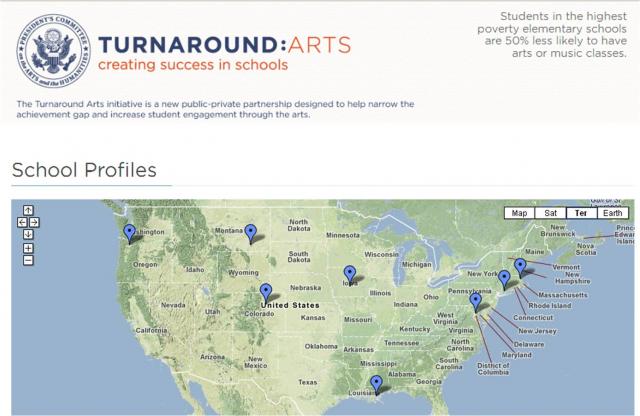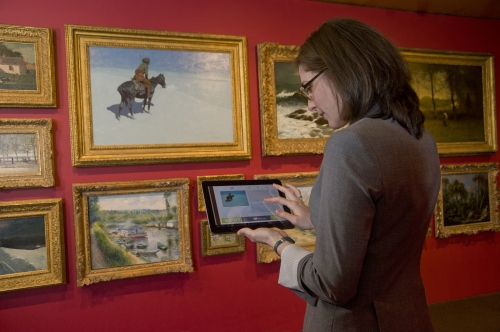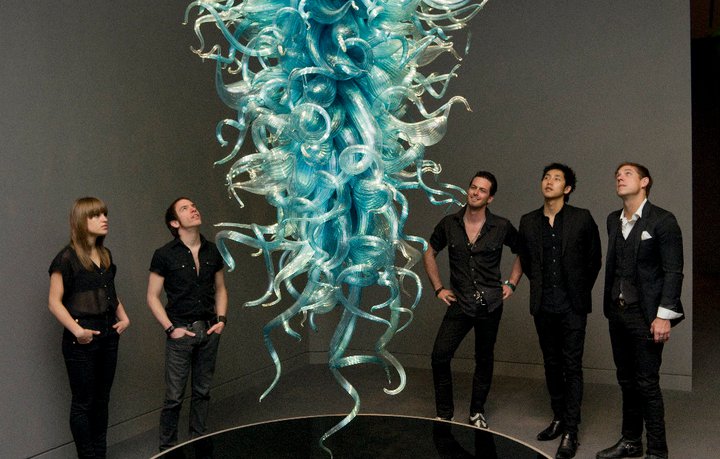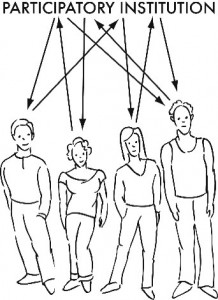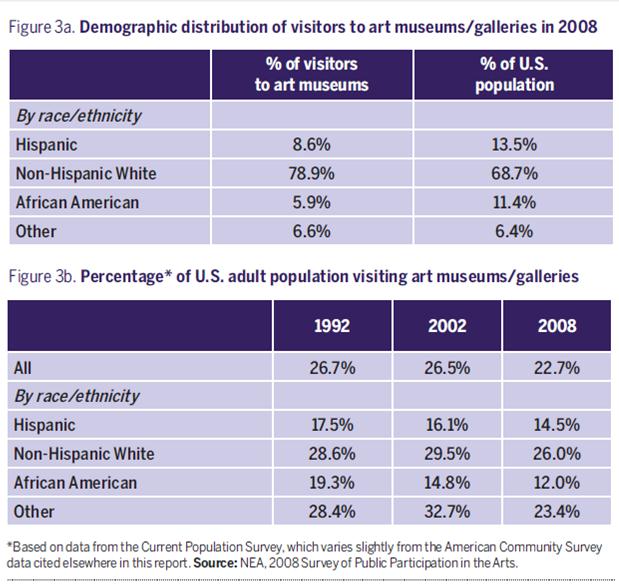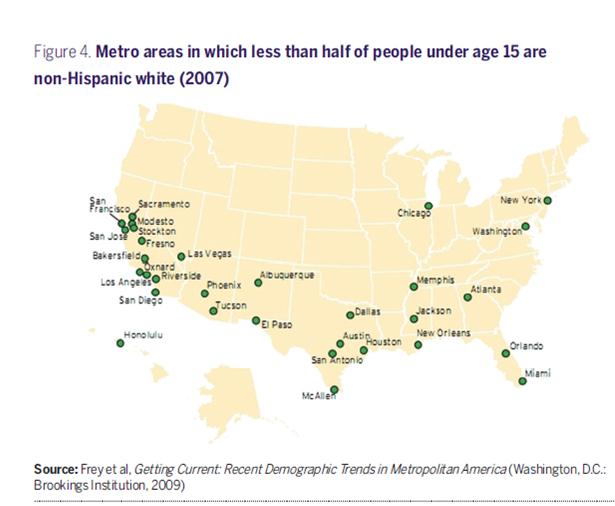Based on over 80 million responses, Hunch blog has complied a rather…intriguing…analysis, and snazzy infographic, of smartphone users- highlighting the trends and differences between iPhone and Android users. What do you think? If you use a smartphone, do you relate to a smartphone-specific trend? How accurate/inaccurate are the findings?
Turning Around Education with the Turnaround Arts Initiative
By now, you have probably read about President Obama’s Turnaround Arts Initiative in the paper, seen a segment about it on the nightly news, or 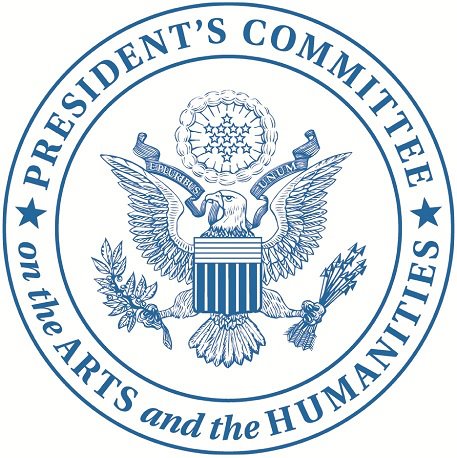 heard about it on Entertainment Tonight between cosmetic secrets of the stars at the Metropolitan Gala and celeb sightings of Blake Lively with Ryan Reynolds (Wedding plans in the works? You didn't hear it from me...).
If you are still curious about the Turnaround Arts Initiative, then this post will provide you with a tidy summary of the program from a policy and arts education perspective. Unfortunately though, this post does not include details on Eva Longoria’s summer workout plan and how-to advice on beating the heat in Mila Kunis-esque summer dresses. Sorry.
heard about it on Entertainment Tonight between cosmetic secrets of the stars at the Metropolitan Gala and celeb sightings of Blake Lively with Ryan Reynolds (Wedding plans in the works? You didn't hear it from me...).
If you are still curious about the Turnaround Arts Initiative, then this post will provide you with a tidy summary of the program from a policy and arts education perspective. Unfortunately though, this post does not include details on Eva Longoria’s summer workout plan and how-to advice on beating the heat in Mila Kunis-esque summer dresses. Sorry.
“We are, as a country, engaged in a national conversation about how to fix our nation’s broken schools. We feel strongly that, while no one strategy alone is a silver bullet, art education should have a seat at the table. Turnaround Arts will test that theory, in addition to bringing effective arts education to thousands of our neediest young people and creating more access to the arts in our most underserved neighborhoods.”
The Turnaround Arts Initiative is:
• an arts education funding initiative in full swing as of April 23, 2012
• a public-private partnership designed to help narrow the achievement gap and increase student engagement through the arts (private partners include: the Ford Foundation, the Herb Alpert Foundation, Crayola, the NAMM Foundation, the Aspen Institute and Booz Allen Hamilton)
• a creation of the President’s Committee on the Arts and Humanities (PCAH), in coordination with the U.S. Department of Education and the White House Domestic Policy Council (other public partners include the National Endowment for the Arts, the Arts Education Partnership, the Council of Chief State School Officers, and the National Assembly of State Arts Agencies)
• testing the hypothesis put forward by the PCAH’s 2011 report Reinvesting in Arts Education: Winning America’s Future Through Creative Schools, that “high-quality and integrated arts education can be an effective tool to strengthen school reform efforts-boosting academic achievement and increasing student motivation in schools facing some of the toughest educational challenges in the country”
• directed at the nation’s lowest-performing elementary and middle schools across the country, known as “turnaround schools” (turnaround schools are in the lowest-performing 5 percent of their state and receive School Improvement Grants through the Department of Education)
• a pilot project at this point, schools have already been selected to participate
• a two-year project, results will be evaluated at that point, program expansion will be considered, and resources will be made available from which ALL schools can benefit
What will the Turnaround Arts Initiative do and how will it be evaluated?
• Provide the selected schools with arts education services, resources and materials to “increase the likelihood of successful school turnaround, engage their community, and raise the visibility of their achievements”
• The key to the program's success is fully integrating the resources into the curriculum, making effective, impactful and rigorous arts programming part of the school’s being
• The impact and effectiveness of arts education in advancing academic achievement, student and community engagement, and overall school performance will be evaluated and reported by Booz Allen Hamilton, a consulting firm, at the close of the two-year term
Why did Entertainment Tonight cover the Turnaround Arts Initiative? Eight under performing schools across the country were selected through an application process. These schools have each been “adopted” by celebrity artists who will remain involved in the school’s curriculum reform by participating in events, performances, and classes. Below is the breakdown of each parent artist and their adopted school(s):
• Chuck Close (award-winning visual artist), Roosevelt Elementary in Bridgeport, Connecticut
• Yo-Yo Ma (award-winning cellist), Orchard Gardens School in Boston, Massachusetts
• Sarah Jessica Parker (award-winning actress), Martin Luther King, Jr. School in Portland, Oregon
• Kerry Washington (award-winning actress), Savoy Elementary in Washington, DC
• Forest Whitaker (award-winning actor), Findley Elementary School in Des Moines, Iowa
• Damien Woetzel (arts leader, previous Principle Dancer with New York City Ballet), Lame Deer Jr. High School in Lame Deer, Montana and Orchard Gardens Schools in Boston, Massachusetts
• Alfre Woodard (award-winning actress), Batiste Cultural Arts Academy in New Orleans, Louisiana and Noel Community Arts School in Denver, Colorado
Is there opposition?
• Diane Ravitch, author and previous U.S. Assistant Secretary of Education under George H. W. Bush and Bill Clinton, says the Turnaround Arts Initiative is just a “teeny, tiny little band-aid on what is a giant, national, festering problem…And it doesn’t begin to address the needs of the schools.”
But we have to start somewhere, right? Many school systems and communities are eager to be included in the program as it offers promising opportunities and resources customized to fit the needs of each school. However, as a pilot project with strict parameters, the Turnaround Arts Initiative is currently focused on evaluating the impact and results of the program on the eight selected schools over the next two years. Meanwhile, schools and the general public can stay informed about the project, its progress, and resources made available by referring to the Turnaround Arts Initiative website, its Twitter feed, and the Arts Education Partnership’s webpage.
Stay informed about the Initiative, stay inspired by its intentions, and keep advocating for arts education funding on a local level.
Confirmed by Nonprofit Quarterly: Generating online content is NOT optional
Just when you thought your nonprofit’s résumé was updated and accurate, it is time to add another job responsibility: publisher.

As recently reported by Joe Waters with Nonprofit Quarterly, “Nonprofit employees have always had to wear a lot of hats: fundraiser, marketer, grant writer, etc. Here’s one more you need to get used to wearing: publisher. Fortunately, this additional job has a real benefit, as it engages current and potential supporters with useful, interesting and credible information that directly drives donor support.”
The key to generating and publishing online content is to be timely, stay relevant, and to “inform, educate and inspire.” Unlike an advertisement, online content allows followers to interact with the information, contribute and hear/see/participate in the organization’s story.
While many of our followers have already identified and addressed the publishing aspect of their nonprofit work, Nonprofit Quarterly offers three reasons why generating and publishing online content is no longer an option for small nonprofit organizations.
1) “It’s part of being a top nonprofit brand”
Build community around your brand and cause by publishing engaging, inspiring, visually compelling and relevant content (and just to clarify, that is NOT your monthly newsletter).
2) “You need to stand out”
It’s a dog-eat-dog world out there. We are all on Facebook, we all have Twitter accounts for our organizations, many organizations maintain blogs—it’s time to step up your online content, videos, podcasts, links, downloadable and free content, etc. Simply having an online presence is no longer enough. Though we prefer to think we are not competing with other nonprofit organizations, the truth of the matter is, we are.
“With more and more nonprofits coming online each year, content is a key tool in separating your nonprofit from the pack. This is especially important as people search for your nonprofit on Google, Bing and Yahoo. Several factors are important in how search engines rank and deliver search results, but one thing is clear: if you don’t produce high quality content and links, online searchers won’t find you. Period.”
3) “You can’t just do good work anymore”
Nonprofit to nonprofit, many of us share similar, philanthropic visions for our organizations. Because of this, the general public has its pick of relevant, benevolent, and noble organizations to support and fund. So now that you can’t claim your work is MORE important or MORE charitable than the next nonprofit’s, how do you get that donor’s attention and dollar? Answer: tell your story in a compelling way, manipulating the resources the web provides. Facebook photo albums, Twitter contests, IncenTix by ShowClix, Pinterest, podcasts, infographics – these and the resources we feature here on Technology in the Arts can help you do just that.
Am I suggesting all nonprofits abandon the newsletter and print medium in this competitive, nonprofit landscape? Of course not. YouTube channels and 140-character-Twitter-contests are wasted on my parents. They look for the newsletter in the mail every month (but continue to impress me when they sign up to receive them by e-mail…way to go, Mom and Dad, makin' me proud).
Publishing online has become increasingly dynamic, visual, and allows for a voice in 3-D; a voice that speaks louder, in more colors, and more emotionally than the traditional newsletter printed and mailed for years and years. Storytelling has moved online with a worldwide audience waiting to feel emotionally compelled, connected, and stimulated by the content your organization generates and publishes.
Playing by the Rules: Creating a Social Media Plan
Your organization has been using social media for some time now. But does the staff know all rules? How to handle and respond appropriately to  negative comments and criticism? What they can and not write on the organization’s page? How to fix errors in posts without compromising the integrity of the content the public has already shared on that post? Are employees allowed to “friend” your organization using their personal accounts? How do you ensure your brand image is enhanced, not threatened by social media usage throughout the organization?
A comprehensive, widely-circulated social media plan can eradicate these issues and guarantee all employees understand the procedures, policies, rules, and expectations for using social media to promote the organization’s brand.
negative comments and criticism? What they can and not write on the organization’s page? How to fix errors in posts without compromising the integrity of the content the public has already shared on that post? Are employees allowed to “friend” your organization using their personal accounts? How do you ensure your brand image is enhanced, not threatened by social media usage throughout the organization?
A comprehensive, widely-circulated social media plan can eradicate these issues and guarantee all employees understand the procedures, policies, rules, and expectations for using social media to promote the organization’s brand.
A good social media policy will provide clear guidelines as to what staff should and shouldn’t do when posting and interacting with the community on a day-to-day basis, freeing them up to think more strategically. It’s also likely to help leadership feel more comfortable with the less-formal nature of social media by letting them establish boundaries for its use. -- from the Nonprofit Social Media Policy Workbook
If you do not have a social media plan, you are surely not alone. However, given this year’s projected estimate that Facebook will exceed 1 billion users and Twitter, 500 million, it’s time to protect what this SIZEABLE population has access to- your brand, your image, and your Facebook wall.
Above all, a social media plan is a LIVING document. As your organization experiments with trending social media platforms, faces new challenges, expands its presence online, or changes its online branding, the social media plan must reflect that growth. Below are guidelines, best practices, and resources to help you clearly define your social media objectives and policies in a complete and effective social media plan. And to clarify, an effective social media plan is not one that controls and restricts participation, rather, facilitates and encourages an open relationship with the public. I’m talkin' 24/7 PR.
1) Meet your new best friend: The Nonprofit Social Media Policy Workbook April 2012 (scroll down the page and click "Download the Report"). Download it. Swear by it. Love it. Be best friends with it forever. Thank you, idealware and Balance Interactive.
2) Determine if your social media plan will address policies for internal social media use (expectations for employee-to-employee use), procedures regarding proper usage and maintenance for PR purposes, and/or community guidelines for participation.
3) Facebook, Twitter and Linkedin are the Big 3. If your organization employs one or all of these, be certain the plan includes specific guidelines for each platform.
4) Video blogs, written blogs, podcasts, wikis, community forums, and on and on and on…these need to be considered as well. Perhaps the plan is not as developed for these various platforms, but nonetheless, expectations for their usage should be made clear if your organization/brand is the subject.
5) RESIST THE INCREASINGLY ATTRACTIVE URGE TO COPY AND PASTE YOUR PLAN, especially when you realize your organization not only uses the Big 3, but also has a YouTube, Pinterest, Tumblr, and Wordpress account…
As Chris Boudreaux, a social media consultant said:
What is important are the differences that are unique to your particular organization and circumstances, and should be based on your business outcomes and how you conduct your business. Just don't copy everyone else's policy and put it in your database of procedures.
6) TRANSPARENCY. How public are we talking? Will the entire world have access to this document (like the Smithsonian Institution and NPR have done), just your Facebook community (as AARP has done in its "Company Information" section), or will it be an internal document for office staff only? Knowing who will receive this information will determine the language you use and the direction you take with it.
7) R egardless of how public the document will be to the outside world- INTEGRATE IT. It should not be considered an isolated document. I’m going to be bold and take a wild guess that at least ONE person on your staff has a personal Facebook account, just one…Your organization's social media users need to know what is considered appropriate and inappropriate to say in reference of the organization, what copyright issues they may face when posting photos, when they can post things that are “off message” and who can friend whom. The social media plan should be included in the organization’s employee handbook- HR and the legal departments should be involved in making this document come to life, too.
egardless of how public the document will be to the outside world- INTEGRATE IT. It should not be considered an isolated document. I’m going to be bold and take a wild guess that at least ONE person on your staff has a personal Facebook account, just one…Your organization's social media users need to know what is considered appropriate and inappropriate to say in reference of the organization, what copyright issues they may face when posting photos, when they can post things that are “off message” and who can friend whom. The social media plan should be included in the organization’s employee handbook- HR and the legal departments should be involved in making this document come to life, too.
8 ) What to say, what to say. The language you use should be clear, as this is a guide for staff and perhaps, the public. For a few examples on strong and clear language in a social media plan, check out this post from Nonprofit Tech 2.0’s blog.
9) Enjoy this cartoon/graphic by Rob Cottingham depicting the process of creating a social media plan.
10) Look at examples of social media policies (213 organizations listed here). Read social media plans that are inclusive of all social platforms. Read plans and guidelines that are specific to blogging or Pinterest. Browse plans of organizations of a similar size and much larger size, of a similar audience and larger audience, and of a similar or completely different mission. While copying and pasting their plan into your own template serves no one, referencing a model will make you aware of things you hadn’t considered, including policies you agree/disagree with and procedures you admire.
Let employees know what is expected of them regarding social media usage. Let the public know what the organization's expectations are for the social media pages themselves and for participation. Keep everyone in the loop, out of trouble, and participating-- with a social media plan.
Lessons from the Bronx
By now you may be aware of the Bronx Museum of the Arts' new ticketing initiative. If not, take a look at the Museum's Facebook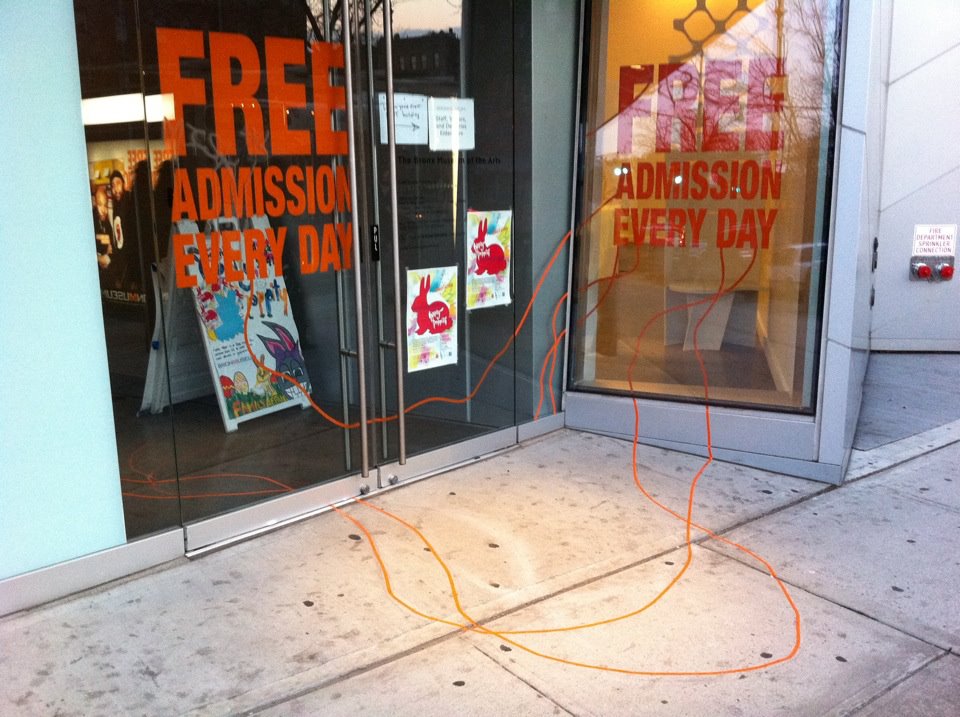 status from March 30th: "Starting today, the Bronx Museum of the Arts will be Free to all. Thursday through Sunday, FREE! First Fridays! FREE. Whether you're 8 or 88, FREE! Getting Here: B/D train to 167th St (Unlike the Museum, the train fare is not free)."
In celebration of its 40th anniversary, the Museum announced just last month it would offer free admission to guests-- this coming at a time when student discounts, twofer deals, good coupons, and gas below $3.99/gallon are at a premium. According to Museum Director, Holly Block,
status from March 30th: "Starting today, the Bronx Museum of the Arts will be Free to all. Thursday through Sunday, FREE! First Fridays! FREE. Whether you're 8 or 88, FREE! Getting Here: B/D train to 167th St (Unlike the Museum, the train fare is not free)."
In celebration of its 40th anniversary, the Museum announced just last month it would offer free admission to guests-- this coming at a time when student discounts, twofer deals, good coupons, and gas below $3.99/gallon are at a premium. According to Museum Director, Holly Block,
With our immediate community being the poorest per capita in the nation, and at a time when many are struggling to pay bills…we don't want anyone to have to use (admission costs) as excuse not to visit us.
It is because of a grant from the New York Community Trust that the museum is able to offer free admission to the public- though the grant only covers admission costs up to 15 months. The Museum is hoping to secure a more permanent funding source to be able to continue to provide free admission to the public after those 15 months.
Not only does this reduce barriers of entry for Bronx residents, New Yorkers, tourists, and artists, but it also benefits the museum community at large. Many museums have implemented similar free admission pilot programs and have reported varying results. It will be interesting to follow up with the Bronx Museum at the conclusion of the 15 month, free admission period to review its attendance numbers and demographics during that time.
While snooping around for more information on the Museum’s new pilot program, I stumbled upon two special offerings at the Museum. How did I NOT know about these programs?!
1) smARTpo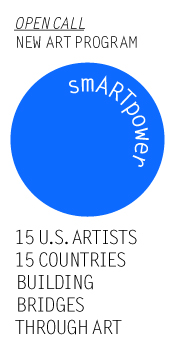 wer: In conjunction with the U.S. Department of State’s Bureau of Education and Cultural Affairs, the Bronx Museum administers this cultural diplomacy program. The program funds and provides travel opportunities for 15 U.S. artists to create and work abroad on a community-based art project. smARTpower supports “the development and implementation of community-based art projects that engage youth and other local residents, including artists. The projects are strongly encouraged to create a tangible legacy of the work accomplished through smARTpower in a variety of visual arts media…” The program is open to professional artists only with U.S. citizenship.
wer: In conjunction with the U.S. Department of State’s Bureau of Education and Cultural Affairs, the Bronx Museum administers this cultural diplomacy program. The program funds and provides travel opportunities for 15 U.S. artists to create and work abroad on a community-based art project. smARTpower supports “the development and implementation of community-based art projects that engage youth and other local residents, including artists. The projects are strongly encouraged to create a tangible legacy of the work accomplished through smARTpower in a variety of visual arts media…” The program is open to professional artists only with U.S. citizenship.
2) Artist in the Marketplace (AIM): Established in 1980, the program seeks to provide “networking opportunities for emerging artists residing in the New York metropolitan area" and to introduce "their work to a greater audience.” Thirty-six selected participants attend weekly seminars led by a faculty of specialists. Topics covered in these sessions “address areas of practical concern to artists including: career management and gallery representation; exhibition and public art opportunities; grant writing, copyright law, and marketing.”
It is a hopeful sign, especially in these financially trying times, when a non-profit arts organization remains so concerned with serving its constituents- accessibility for its local audience, professional advancement for its arts community, and greater cultural understanding in diplomacy efforts.
Motion-Capturing Conductors, Pianos & Landmines, and Facebook & Twitter Symbols
A roundup of my favorite applications of arts and technology this month:
1) Music and Gestures: Capturing the Movement of Conductors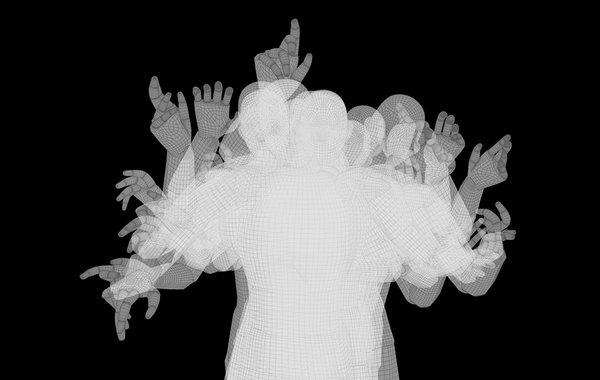
In “The Maestro’s Mojo,” Daniel J. Wakin of the New York Times interviews Alan Gilbert, the music director of the New York Philharmonic. The article discusses the importance of the conductor's form, gesture, and physical presence during a concert, breaking down the essential components of each movement: right hand, left hand, face, back, lungs and brain.
What is most revealing, not to mention beautiful, is the motion-capture sequence and interactive demonstration of Gilbert’s movement and gestures while conducting. Even if you view the interview with the sound on mute, the digital simulation of Gilbert conducting is worth your time. Captured in this digital transformation is the grace, the lines and the precision of a conductor at work. The digital transformation is both a work of art in itself and a fascinating study of the movements that perhaps, so nuanced, evade even the most cultivated and experienced concertgoer.
[embed]http://www.http://vimeo.com/40095898[/embed]
2) Pianos and Landmines
Did you catch this story earlier in the month? It’s about Marian Bechtel, a 17-year-old finalist in the 2012 Intel Talent Search competition. Bechtel presented her invention of a low-cost minesweeper that uses sound waves to detect explosives. A pianist, Bechtel applied her knowledge and expertise on the logistics of sound wave travel in music, to that of determining the location of land mines. Though her minesweeper prototype did not win her first place in the competition, Bechtel’s inspirational and innovative discovery is one that spans the fields of science, engineering, technology, warfare, humanity, and music- the juxtaposition of melodic beauty and peace, with war and destruction.
[embed]http://www.youtube.com/watch?v=nGW2qAHLJCc[/embed]
3) Not about music, but some good news about Facebook and Twitter Logos!
And last but certainly not least, proof that those little, cute, perfectly-square Facebook and Twitter symbols DO, in fact, generate traffic to the organization’s respective pages. According to a study conducted by the global consulting firm, Accenture (shout out to Technology Planning and Implementation),
Accenture found that, in the U.S, about a third of TV viewers have liked a show’s or brand’s Facebook page or tweeted about what they saw on TV after seeing one of these logos.
This implies that a television viewer, if not using his/her computer at the time the advertisement is viewed, will "like" or visit an organization's Facebook or Twitter page after the fact. If that is the case, are the benefits of including the logos in your organization's e-mails and correspondences with patrons even greater? Furthermore, the study indicated
…11% of viewers scanned a QR code while watching TV.
Given what we know about QR code usage in the US, and its slow-to-catch-on-if-ever status, 11% is a surprisingly high number.
Moral of the story? Be sure to include those Facebook and Twitter symbols in every e-mail blast, online correspondence, and virtual newsletter. Your Facebook or Twitter presence is important. Inserting the logos in an e-mail is quick, free (monetarily) and according to what you probably already knew and is now confirmed by this study, a crowd-pleaser. People will click, Tweet, post, Retweet, and follow.
Engaging Technology: uCurate and uExplore at the Clark
What’s going on at the Sterling and Francine Clark Institute in Williamstown, Massachusetts? Let’s see, there are iPads, tablets, interactive digital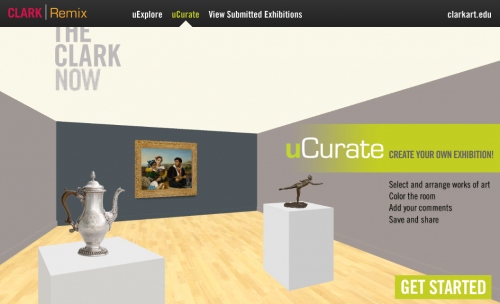 programs, touchscreens and kiosks throughout the galleries, the new exhibition, Clark Remix, and oh yes, new curators- YOU.
In a February press release, the Clark announced its exciting new initiative to encourage visitor interaction and participation in its galleries. According to the press release, Clark Remix is "a dynamic salon-style installation featuring some 80 paintings, 20 sculptures, and 300 of the institute’s finest examples of decorative arts."
programs, touchscreens and kiosks throughout the galleries, the new exhibition, Clark Remix, and oh yes, new curators- YOU.
In a February press release, the Clark announced its exciting new initiative to encourage visitor interaction and participation in its galleries. According to the press release, Clark Remix is "a dynamic salon-style installation featuring some 80 paintings, 20 sculptures, and 300 of the institute’s finest examples of decorative arts."
As part of the exhibit, the Clark has introduced the interactive, digital programs uExplore and uCurate. Both programs are accessible online, on the visitor’s own personal device, on touchscreens and kiosks throughout the gallery and on iPads and tablets provided by the Clark for use in the museum. Basically, the programs are EXTREMELY accessible and user friendly- I myself have spent all afternoon here in Pittsburgh exploring the Clark’s collection and building my own exhibition, instead of reading for class (ahh priorities).
The Director of the Clark, Michael Conforti explains the premise of Clark Remix,
Clark Remix represents one of many programs that the Clark is developing to engage audiences in exciting ways. Clark Remix allows us to present our permanent collection in an installation that is both beautiful and innovative. Our salon-style presentation provides a very different and intriguing perspective on many of the works that have become familiar favorites for Clark visitors. Adding virtual components to the exhibition allows us to reach new audiences and invite them to discover and interact with our collection.
It works like this. uExplore allows the visitor to learn more about the Clark’s collection in a visually stimulating, highly organized, and digitally oriented way. Items are grouped into categories (paintings, sculpture, glass silver and ceramics) to allow the user to navigate with ease through the extensive collection. Selecting an image of the desired object, a more detailed, but not overwhelming, explanation of the item becomes available. When appropriate, audio and video clips accompany the information.
It is a beautifully designed and easily navigable interface. uExplore’s presence in the gallery encourages visitors to delve more deeply into the history of the collection, while they are on-site.
The second digital application to accompany the exhibit, uCurate, gives visitors the opportunity to participate in the curatorial process. As the name implies, YOU, aka the visitor, plan and design a 3D virtual exhibition with the Clark’s collection. The participant makes all decisions, from what to include and how to arrange
the objects, to wall color selection and wall text. Users of the program have the option to submit their designs for consideration by Clark’s curatorial team AND to share their designs through social media channels (promoting the museum and the digital program). Submissions to the Clark will be reviewed regularly. Why submit your design for professional review by Clark curators? Because if selected, the virtual design will be transformed into an actual exhibition! The lucky designers will be invited to assist in their exhibition’s installation, in the decision-making process, in the creation of wall text and in writing the curator’s statement.
uCurate and uExplore were designed by the Clark in collaboration with Swim Design Consultants and Virtual Gallerie to afford the public a voice and role in the museum’s exhibition planning process. Allowing the public to suggest actual designs for implementation challenges what has been the accepted and traditional decision-making process in the museum. That is, all decisions are made internally; the public only receives, not contributes. But the Clark is trying something different. In a recent New York Times' article on the Clark’s innovative crowd-sourcing approach, Conforti said,
For generations, curators ran the show and told you what to believe. In a world of blogging and Wikipedia, we realized that we can learn from our audience, and from multiple interpretations.
This is Museum 2.0 in action. Where visitors become users and museums become, as Nina Simon explains, “dynamic platforms for content generation and sharing.”
for content generation and sharing.”
So Kudos to you, Clark Museum. This is an engaging and relevant use of technology where the user AND museum win.
Facebook, Alternative Bands and Acoustic Sessions @ the MFA
To me, this just about sums up the 21st century Millennial: Facebook invitations, exclusive access to acoustic sessions, alternative bands, 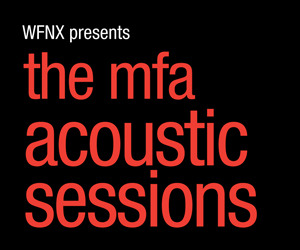 behind the scenes privileges, access granted only through social media and a little culture via the fine arts. To what pray tell could I be referring? Why, Boston’s Museum of Fine Arts’ (MFA) partnership with radio station WFNX, of course.
Since May 2011, the MFA Boston has been showcasing nationally acclaimed acoustic bands in its galleries. Each month, an alternative band and 35-50 lucky winners are selected to participate in the exclusive Acoustic Sessions series.
behind the scenes privileges, access granted only through social media and a little culture via the fine arts. To what pray tell could I be referring? Why, Boston’s Museum of Fine Arts’ (MFA) partnership with radio station WFNX, of course.
Since May 2011, the MFA Boston has been showcasing nationally acclaimed acoustic bands in its galleries. Each month, an alternative band and 35-50 lucky winners are selected to participate in the exclusive Acoustic Sessions series.
How does one get selected to attend? Here’s where the Millennial wins. The concerts are announced on the MFA’s Facebook page and live on WFNX Radio (tune in on 101.7 FM in the Boston area). Interested followers can submit an entry form on the MFA’s Facebook page or call in to the radio station to be selected.
How does it work? The MFA’s upcoming Acoustic Series concert on March 27th is advertised on its Facebook page in the following post:
The MFA and WFNX have teamed up to present some of the best alternative bands, live in the galleries and Kasabian plays next on March 27. You can only see them by “liking” us and entering to win tickets here or listening to WFNX.
According the program’s press release, the artists perform in various galleries- from the European Paintings to the Contemporary American Art room. Their performances are sound and video recorded. They are then shared online, both on the MFA’s Facebook page and WFNX’s webpage.
Just when you thought it couldn’t get any more Millennial friendly, the MFA throws in this added exclusive- the performing musicians’ participate in the Museum’s “Art We Love”
program. The musicians select their favorite work of art in the museum, explain why they chose it or its significance to them and are then photographed beside the work. The photographs are uploaded to the MFA’s Facebook page for all to enjoy
and explore, providing unique insight and exclusive information on the musicians.
It is a perfect example of how the collaboration between social media, the visual and the performing arts can enhance the public's artistic experience and engage even those difficult Millennials. Originally from the Boston area, I am proud to share the MFA’s innovative programming with those from away. But I am sure other museums and galleries are up to similar projects. What other museums and galleries have similar, or completely unique, social-media driven, collaborative programs?
The Best of Both Worlds: QRpedia.
While scanning a quick response (QR) code on the back of a cereal box only to find it directs you to the cereal’s web site is, how can I put this 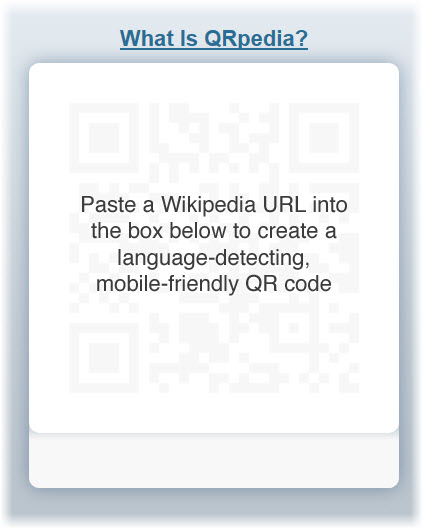 politely, fun (that’s my attempt at sarcasm), it neither reflects the appropriate usage nor does it maximize the potential of those nifty little black and white squares.
There's the cereal box QR code, and then there's QRpedia. QRpedia is a program announced by the Wikimedia Foundation in September 2011. It is currently competing in Barcelona at the Mobile World Congress for the title of the United Kingdom’s “most innovative mobile company.” Today, on February 29th, the winner of the award will be announced. The reward? The United Kingdom Trade and Investment’s (UKTI) support to expand the company internationally.
politely, fun (that’s my attempt at sarcasm), it neither reflects the appropriate usage nor does it maximize the potential of those nifty little black and white squares.
There's the cereal box QR code, and then there's QRpedia. QRpedia is a program announced by the Wikimedia Foundation in September 2011. It is currently competing in Barcelona at the Mobile World Congress for the title of the United Kingdom’s “most innovative mobile company.” Today, on February 29th, the winner of the award will be announced. The reward? The United Kingdom Trade and Investment’s (UKTI) support to expand the company internationally.
But enough about the competition. What exactly is QRpedia and how does it work in the museum setting? It functions just as an ordinary QR code does, except for its whole language-detecting brilliance. A Polish speaking viewer walks up to, let’s say, Claude Lorrain’s Seaport at Sunset (1639) hanging in the Louvre in Paris. In front of the text panel, the visitor whips out his/her smartphone and snaps a photo of the QRpedia code. The QRpedia code instantly detects the phone’s language and the browser opens to a Wikipedia article on the painting or related topic in that written language. If an article on Claude Lorrain’s Seaport at Sunset isn’t available in Polish, the QRpedia code will direct the user to the next most closely related topic available in that language, perhaps an article on the French, 17th-century landscape painter, Nicolas Poussin.
QRpedia’s language-detecting technology makes it truly unique. For foreign visitors, this eliminates the expense of an audio guide from museum visits (if there is a guide even available in their preferred language) and replaces it with the ease of snapping a photo, the interactivity of a QR code and the straight-forward, mobile-formatted information of a Wikipedia article.
[embed]http://www.youtube.com/watch?feature=player_embedded&v=aXCUOpBytxA [/embed]
Terence Eden, the lead developer of QRpedia, says
QRpedia is the perfect way to get access to massive amounts of cultural information. A typical museum display has less than a paragraph of text, often just in one language – QRpedia can give encyclopedic information in hundreds of languages. Recently, in Derby Museum, a painting by Joseph Wright was taken away for cleaning. The Museum staff have put a QRpedia code in its place so that visitors can still see a high quality image of the painting, and read information about the painting and its creator.
The program was created at the Derby Museum and Gallery in England. Today it is available online for any and every museum, gallery, library, public park, archive, historic landmark and so on. QRpedia has been implemented at numerous prestigious museums and galleries worldwide, including the United Kingdom’s National Archives and Spain’s Fundació Joan Miró. How about the United States, you ask? Why yes! It has been implemented at the Children’s Museum of Indianapolis. But why stop there? Its usage is not limited to arts and cultural institutions. Fun fact- the Occupy movement uses QRpedia codes on its posters and publications to disperse information to a wide and diverse audience.
What’s in it for the museum? A lot, actually.
1) You can create your own, online, as often and as many as you want.
2) For museums with multilingual audiences, a text panel can become cluttered and overwhelming with various translations. Additionally, the space allotted to provide relevant information becomes increasingly limited with numerous translations, causing you to cut-back even further on relevant information.
3) Because Wikipedia is editable, a curator, exhibition director, museum official or artist can translate articles to various languages and create articles if there is a void. That being said, so can anyone else. But be brave. Be bold. Be confident in the power of the public intellectual collective.
4) According to Roger Bamkin, the co-creator of QRpedia and the chair of Wikimedia UK, “We see e-volunteers giving thousands of hours to support museums... Hundreds of new articles have been created in dozens of different languages.” Beyond printing the codes, I’d say the work is done almost entirely for you.
5) QRpedia codes are not limited to paintings and items in your collection. Incorporate them in museum signage, directionals, cafe menus, etc.
6) QRpedia  also records usage analytics. Museums, galleries, whoever, can track the number of QRpedia users, the paintings with the most QR code action, the most common languages, etc. In my humble opinion, it offers a rather innovative way to get to know your audience.
also records usage analytics. Museums, galleries, whoever, can track the number of QRpedia users, the paintings with the most QR code action, the most common languages, etc. In my humble opinion, it offers a rather innovative way to get to know your audience.
Accessible, innovative, interactive (for those inside the museum and those elsewhere translating Wikipedia articles without any intent to ever visit the museum…), and FREE. For museums and cultural institutions looking to expand into the QR code realm, this is the place to start. The Wikipedia articles are already written, online, and translated. Why not offer your visitors a more complete museum experience in their preferred language?
Leading with Social Design at Facebook’s Analog Research Lab
“Everything just is,” says Christopher Cox, Vice President of Product at Facebook. Photos is an application for photos, Events is f or events, and Groups is for groups of people. Though many criticize Facebook’s interface and design as bland and uncreative, its designers at the Analog Research Lab test their ideas and design decisions in a highly informed way. According to a design mind article by Reena Jana, the Analog Research Lab is the company’s creative design space used to
or events, and Groups is for groups of people. Though many criticize Facebook’s interface and design as bland and uncreative, its designers at the Analog Research Lab test their ideas and design decisions in a highly informed way. According to a design mind article by Reena Jana, the Analog Research Lab is the company’s creative design space used to
...create branded marketing materials—T-shirts, for instance—for developer conferences and other Facebook events. It’s also where designers experiment with simple fonts and sleek iconography that will eventually influence what appears on the Facebook website.
I had never heard of Facebook’s Analog Research Lab. But its purpose, products and success reminded me of topics I have discussed in previous posts. For example, consider Facebook’s design decisions in light of Nina Simon’s The Participatory Museum. Facebook has certainly managed to promote a social experience that is accessible, meaningful and unique to each user, in large part due to the structure format and design elements the creative team at the Analog Research Lab develops.
Or consider artist Tanja Hollander’s most recent project, Are You Really My Friend? The Facebook Portrait Project, exploring the (d)evolution of human relationships as a result of our simultaneous existence in two worlds- the virtual and the real. At the Lab, designers are on a mission to make virtual interactions between individuals less cyber and more real.
The Analog Research Lab is not staffed with full-time employees. Instead, it serves as a space for Facebook designers to express the company and the brand using tools and techniques that are, get this, non-digital. The lab is stocked with a printing press, wood cutting tools, ink, a dark room for developing photos, drying space, etc. It encourages designers to focus purely on design, design techniques, and simpler, less complicated design strateg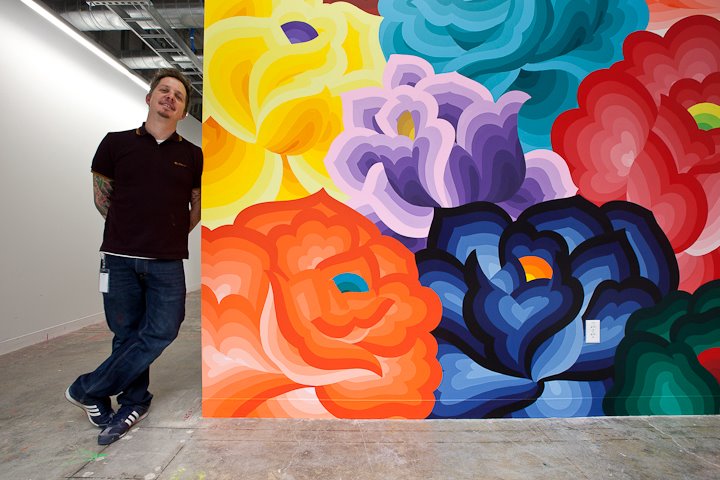 ies. True to its name, the Analog Research Lab is also a design research space. Colors, fonts, styles, shapes, etc. are tested on real people to gauge their future success and popularity online. The designers also use the space to make motivational, quirky screenprinted posters. Lots of them. So. Cool.
ies. True to its name, the Analog Research Lab is also a design research space. Colors, fonts, styles, shapes, etc. are tested on real people to gauge their future success and popularity online. The designers also use the space to make motivational, quirky screenprinted posters. Lots of them. So. Cool.
The Lab also serves as the home of Facebook’s new Artist-in-Residency program, a project to create, support and install offline artwork in Facebook’s offices. The first artist, Jet Martinez, recently completed a large, colorful mural titled “Bouquet” to beautify the walls of Building 17, where the company’s engineers work their magic.
Facebook’s offline and online design decisions aim to support human-to human interactions. This may come as a surprise, especially in light of the charged sociological and anthropological discussions that social media has forever affected (for the worse) humans’ ability to interact, engage and relate to one another in the physical world. Facebook’s creative leadership, including Cox, Ben Barry and Everett Katigbak, are committed to the design approach of “social design.” Updates to Facebook’s features, product development and design are made in response to users and their online behavior. Jana explains this approach as one that
…improves how people build human-to-human, versus human-to-interface, connections online.
Take for example one of the Lab’s stationary products- postcards printed with the word “Poke” in red letters. The design is in obvious reference to the virtual action of “poking” a friend on Facebook. To support the human-to-human connection, designers in the Lab created printed postcards, with non-digital design tools, for Facebook employees to write hand-written messages to send through good old fashioned, snail mail. The creative work done in the Lab explores the overlap and divide between cyber and physical interactions- translating Facebook's interactiveness in the digital realm to a tangible reality in our inhabitable space.
It is a neat space- the perfect dichotomy of trendy, vintage workshop and hip, old-school office. I am always curious to see how technology companies incorporate offline art and celebrate non-digital artists in their physical space, if they even do so. Are there other technology companies with similar artistic, in-house projects like Facebook's Artists-in-Residency program? Do technology or digital design companies have a responsibility to support non-digital and offline art? Are cyber users more attracted to online interfaces with simpler, non-digital design elements? Take a look at your own Facebook page. Think about the scaffolding, constraints and structured components that ironically, like Simon suggests, make self-expression so much easier and fluid.
The Participatory Museum: A Must-Read Book for Current and Future Arts Managers
Traveling this weekend, I decided to put aside my school work, leave my laptop at home and finally read Nina Simon’s, The Participatory 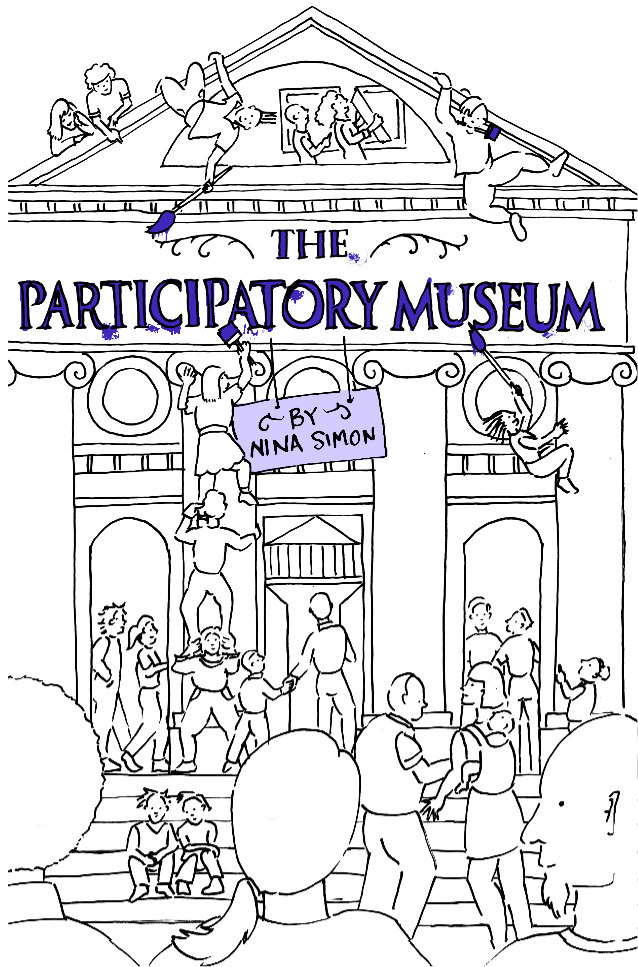 Museum.
As an arts management student, I cannot emphasize enough just how relevant this book is for cultural institution administrators, especially future ones. I have decided procrastinating over the weekend was in the name of the future of museums (at least that’s what I’m telling myself…).
Museum.
As an arts management student, I cannot emphasize enough just how relevant this book is for cultural institution administrators, especially future ones. I have decided procrastinating over the weekend was in the name of the future of museums (at least that’s what I’m telling myself…).
Nina Simon, the author of the book and Museum 2.0 blog, is the Executive Director of the Museum of Art & History in Santa Cruz. Simon shares her own experiences of visiting, working and participating (or not) in museums throughout the book. What I find most critical to the book’s success in discussing participation in the museum setting, and doing so credibly, are the countless examples and case studies ranging from science museums to art museums, and Simon’s personal, professional accounts to events she observed and experienced. The case studies are relevant, contemporary, and thematically and geographically diverse.
The purpose of this post is not to offer a summary of the book, though if it were, I would say this: it is an introduction, resource and guide for cultural institutions on where/when/why/how to engage visitors as “cultural participants, not passive consumers.”
Instead, I will focus on three components of visitor participation and engagement: the different types of participants, the need for constraints and the four models of participation.
Until this weekend, I was under the impression there are two types of museum goers: those who will sit down at a computer screen to video record their reaction to an exhibition as prompted, and those, like myself, who will not. I don’t think I’m alone in that fallacy either. If video-recording or commenting on my experience is the extent of the museum’s participatory program, well then, I’m out of luck. Simon applies research conducted by Forrestor Research to explain the participatory trends and types of audiences in the cultural institution setting. These audiences are:
1.The creators
2.The critics
3. The collectors
4. The joiners
5. The spectators
6.The inactives
Think about YouTube and Flickr. These social media sites encourage participation from all types of audiences, including those who want to post content, share videos and upload photos (the creators); those who want to publicly like, dislike and rate content (the critics); those who like to aggregate the videos and photos they most enjoy in their own profiles (the collectors); those who are members or have an account on social network sites (the joiners); those who consume the videos, photos and blog posts of those who create them (the spectators); and finally, those who have no interaction with online social sites (the inactives).
Ah ha! So those of us who don’t feel comfortable sharing at the video commenting station aren’t lazy museum participants! Rather, the museum has neglected to incorporate a means of participation that engages our type of audience. It is often the case that cultural institutions engage either the creators of user generated content, or the spectators, polarizing the museum audience into those two groups.
Knowing there are critics, collectors, joiners and the inevitable inactives who have what Simon calls, “intermediate participatory behaviors,” a museum must create participatory experiences to discourage participation inequality and to encourage engagement.
Participation inequality leads me to my next point. To encourage participation from all audience types, exhibits must be designed with limitations, constraints and scaffolding. This may seem counter-intuitive if you want open, unrestricted and expressive responses from your audience. However, open-ended questions and activities cause many visitors to run away in fear and self-consciousness. My most favorite art-related quote (by Oscar Welles) so brilliantly addresses this barrier to participation, productivity and creativity: “the enemy of art is the absence of limitation.”
Simon writes
The best participatory experiences are not wide open. They are scaffolded to help people feel comfortable engaging in the activity. There are many ways to scaffold experiences without prescribing the result…A supportive starting point can help people participate confidently – whether as creators, critics, collectors, joiners, or spectators.
Scaffolding and constraints make participating less daunting and audiences feel more confident in themselves and their ideas. Simon provides examples and case studies of successful, constrained projects and activities that engage all types by limiting self-expression and open-ended opportunities. This is brilliant. Is it a completely new idea? No. But Simon provides all the information you need to create quality outcomes for all. She explores what limitations in the cultural institution setting are, how they work, why they work, who they benefit, and how you can implement them in your organization.
Now that we understand the diverse needs and types within the audience and how to scaffold the creative experience, we can now take a look at Simon’s four different models for participation:
1. Contributory
2. Collaborative
3. Co-creative
4. Hosted
The second half of Simon’s text focuses on each model of participation. You can access a handy PDF version of Simon’s matrix that organizes each model according to the organization’s commitment to community engagement, need for control in the participatory process, vision of relationship with the participants, goals for the participants and nonparticipants, etc.
Depending on the organization’s mission, capacity and the situation, different models of participation will be more effective than others. The most critical factor to determine when deciding what model of participation to employ is the extent of control the organization wants over the process and its participants. Once the question of control has been addressed, museums can then determine their vision and desired outcomes for the project, the type of participation activities required to reach those goals and the role of museum staff. The final task is to measure the success and impact of the participatory project.
I recommend this book to current students and professionals in the museum field. As we enter an age of an increasingly diverse society, it will become even more critical for museums to create opportunities that encourage all audiences to attend, engage and participate.
The Participatory Museum is available in three formats: as a paperback book ($25), a downloadable file ($18), and online (free). I encourage our Technology in the Arts followers to read the book, or simply a chapter of it, and contextualize the material in terms of your own arts organization- be it a museum, community center, arts center or gallery. How do you currently encourage visitor participation? Are you engaging all types of participants? If not, what types of programs, projects or exhibits can your organization support to better engage more visitors?
For further information, check out this previous Technology in the Arts post on a talk given by Simon at the Pittsburgh Children's Museum.
Speaker Series' Spotlight: Chad M. Bauman, Director of Communications for Arena Stage at the Mead Center for American Theater
On February 10th, the Master of Arts Management program at Carnegie Mellon University will welcome Mr. Chad Bauman, Director of Communications for Arena Stage at the Mead Center for American Theater to speak as part of our Speaker Series. His presentation, Confessions from an Arts Marketer – Learning from the Past, Looking Toward the Future, will highlight the worst practices in the field, what can be learned from them, and how to move beyond them.
I recently chatted with Chad and talked Tweet Seats, fire in the belly, and what he wished he had known about the field from the very beginning…
Speaker Series. His presentation, Confessions from an Arts Marketer – Learning from the Past, Looking Toward the Future, will highlight the worst practices in the field, what can be learned from them, and how to move beyond them.
I recently chatted with Chad and talked Tweet Seats, fire in the belly, and what he wished he had known about the field from the very beginning…
Elizabeth @ Technology in the Arts: You’ve held top, senior positions as the previous Director of Marketing and Communications for Americans for the Arts and now as Director of Communications for Arena Stage. You’ve clearly figured it out. But even so, what’s the one piece of advice you wish you had received before entering the field?
Chad Bauman: I am very thankful for my education from CalArts in Producing and Theater Management. But I would have to say…I wish I had learned how to get stuff for free. When you are first starting out, it’s how good are you at convincing people to give you stuff for free- advertising space, promotional opportunities…it’s absolutely critical for smaller companies; you have to do it really well.
E: Now, with all the social media networks out there, it must be easier to get recognized and make connections with those who CAN give you stuff for free.
C: Earlier on, it was super controversial for arts organizations to be on social media; they didn’t understand what the value would be. It also used to be a smaller company could distinguish itself on social media, but now there is a lot more clutter. Being on social media is an exceptional way to get free promotion, but now you have to compete with everyone else out there.
E: So I have to ask, in your opinion, which is the better platform to get a message out and to get attention, Twitter or Facebook?
C: I’m liking Twitter more and more. It’s the most efficient platform. It began with Friendster, then MySpace, then Facebook. I think Facebook use is on the decline and Twitter is on the incline. It’s more of a conversational tool.
E: How about audience members Tweeting during a show? Tweet Seats?
C: You have to be careful; you have to find a balance with Tweet Seats. There was a case where a theater established Tweet Seats for a show, but the resident writers of the production were never consulted and they were not on board with it.
E: What are you more in favor of then, Tweet Seats or post-experience Tweeting?
C: I am more in favor of post-experience Tweeting. You can’t get the full experience if you are on your phone, you’ll miss something. You can miss the most crucial detail, especially in a very nuanced performance. There are many other ways to invite conversation about a production.
E: For those of us logging in hours on online job boards and stalking career services on an daily basis, what are the qualities you look for as Director in a potential employee or intern?
C: Fire in the belly. By that I mean, a person who is internally motivated. I’m not sure you can teach it. They want to do a great job and are motivated by wanting to do a great job. You can teach skills, but you can’t teach internal motivation.
E: In particular to marketing?
C: I look for people who are not afraid to take risks, calculated risks, but risks nonetheless. You have to be willing to take a risk in an entrepreneurial spirit.
E: We, my fellow job and internship seekers, thank you for that advice! I don’t want to take up too much more of your time, so one last question. In a recent blog, I looked at the changing face of America over the next four or five decades and its shift to a minority-majority population. How can visual arts or performing arts organizations expand their audience to reflect this change?
C: First, it’s about programming and community outreach. At Arena Stage, we go out into the community, to churches, to schools, to make personal relationships. You can communicate to younger demographics about your organization’s activity and productions using technology tools. But it’s about programming. Marketers are very good at targeting a specific demographic and figuring out what tools to use. But regardless of the tool, there has to be an interest in the production or the organization’s mission.
You can read more about this Speaker Series event on the Master of Arts Management Speaker Series' website, discuss arts marketing with Chad on his blog, and find further information about the Master in Arts Management (MAM) program on the Heinz College webpage.
Interview with Chad Bauman conducted and condensed by Technology in the Arts contributor, Elizabeth Quaglieri.
Videos to make your Wednesday less like Wednesday and more like Friday
It's Wednesday, sigh. To help with your mid-week blues, here are a few humorous and just plain cool videos. Ever wonder…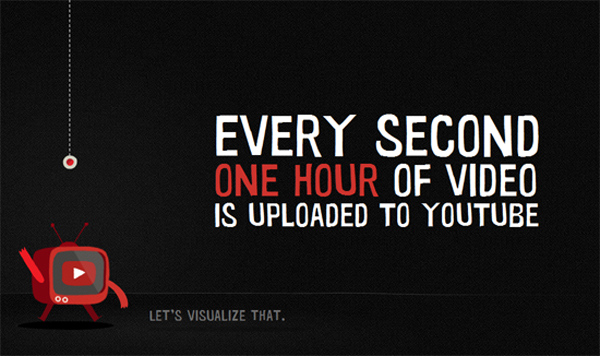 …what it would be like to work for Twitter? We regularly emphasize the benefits of Twitter and other social media networks for arts managers, fundraisers, developers, marketers, PR personnel, etc. So today I offer a break from the usual discussion about Twitter and instead, an “over-budget,” under-informative and comical video highlighting the Twitter office experience featuring Twitter CEO Dick Costolo…
…what it would be like to work for Twitter? We regularly emphasize the benefits of Twitter and other social media networks for arts managers, fundraisers, developers, marketers, PR personnel, etc. So today I offer a break from the usual discussion about Twitter and instead, an “over-budget,” under-informative and comical video highlighting the Twitter office experience featuring Twitter CEO Dick Costolo…
[embed]http://www.youtube.com/watch?v=vccZkELgEsU[/embed]
…how much video is uploaded to YouTube a day? Then check out this website that visualizes just how much video it is in comparison to other worldly and environmental phenomena.
[embed]http://www.youtube.com/watch?v=sHPfc6whaSk[/embed]
…about a popuphood? It’s exactly what it sounds like, a neighborhood or block of pop-up stores. But these aren’t your typical, temporary pop-up stores. In an urban initiative to revitalize the historic Old Oakland neighborhood in Oakland, California, popuphood is providing six retail store owners with free rent to occupy vacant storefronts in the neighborhood. The ultimate goal is for the six stores to be successful enough at this location to sign a long term lease upon the close of the first six months. Innovation in economic and urban development at its very best.
[embed]http://vimeo.com/evakolenko/popuphood[/embed]
Hope these ideas make your Wednesday all the more pleasant!
Cultivating a More Diverse Audience: The Future of Museums
A 2010 report published by the Center for the Future of Museums, an initiative of American Association of Museums, forecasts the changing face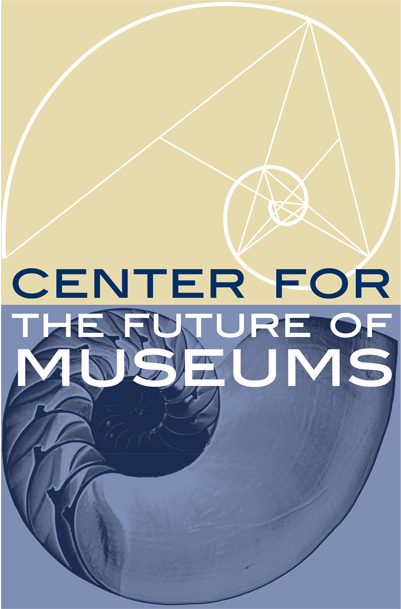 of the United States over the next four decades and the future of museums in light of an increasingly diverse population and “majority minority” society. The report, “Demographic Transformation and the Future of Museums” is a must-read for museum managers and administration- if only for the graphics and statistics projecting the upcoming drastic and rapid shift in demographics in the United States.
A concise report, complete with graphics, a call to action, and a list of online resources for demographic information and socio-economic indicators, the American Association of Museums (AAM) analyzes the data on patterns of museum use and trends in societal growth to answer the questions
of the United States over the next four decades and the future of museums in light of an increasingly diverse population and “majority minority” society. The report, “Demographic Transformation and the Future of Museums” is a must-read for museum managers and administration- if only for the graphics and statistics projecting the upcoming drastic and rapid shift in demographics in the United States.
A concise report, complete with graphics, a call to action, and a list of online resources for demographic information and socio-economic indicators, the American Association of Museums (AAM) analyzes the data on patterns of museum use and trends in societal growth to answer the questions
How will people use museums in the future? And which people will use them?
The forecasted demographic transformation directly affects the museum audience and museum professionals as today’s typical museum goer, a 45-54 year old non-Hispanic white adult, is no longer an accurate reflection of the American public.
Below is a summary of the report’s key findings, surprising statistics, focus group outcomes and suggestions on how to cultivate a diverse, museum audience that’s users reflect the diverse, 'majority minority' communities of America’s future.
Sometime between 2040 and 2050, depending on which projection model is employed, the current U.S. minority groups- African Americans, Latinos (of any race), Asian Americans and Pacific Islanders, Native Americans and others, including those identify as multiracial- will collectively become the new majority in the United States. The proportion of non-Hispanic whites will fall below 50 percent for the first time since the country was founded.
The future of American society is one of “majority minority” in which disparate groups and minorities constitute the collective majority of the population. This compares to the data collected from 2008 on the racial and ethnic composition of the U.S. population in which, by both race and ethnicity, Whites and non-Hispanic whites, made up 74.3% and 84.9% of the population.
The AAM recognizes the imperfections of the monolithic and conventional categories of white, black, Hispanic, and Asian as more and more individuals seek a more multi-racial and ethnic option for classification.
While there are many factors affecting an individual’s decision to attend what the National Endowment for the Arts terms “benchmark arts” (attendance at musical plays, non-musical plays, jazz concerts, theater, opera, classical music performances, the ballet and visual art venues), such as distance, accessibility, cost of admission, income and education, the latter two are most often the major determinants of attendance.
Who has traditionally been the art museum user? And who will it be? While the percentage of the U.S. adult population visiting art museums/galleries declined by 4% between 1992 and 2008, non-Hispanic whites, ages 45-54, are the predominant attendees. Consider this graphic:
If the forecast for the next four decades is correct and the current pattern in museum attendance remains unchanged, art museums and galleries will not serve the majority of the American population. There are economic, cultural, historic, educational, scheduling and interpersonal barriers to entry that affect an individual’s decision and motivation to attend; however, these barriers must be broken in order to create a more inclusive and inviting museum experience for the future America.
What can be done to increase museum/gallery attendance among diverse groups and reduce the great ethnic and racial disparities in museum participation? It is up to the museum administrators, managers, marketers, developers, programmers, educators and front-line personnel.
Know your audience. All of them. Know your neighborhood and community. Read the newest research. Many Urban Studies institutes have published reports on why specific demographics do or do not attend museums or visual art venues. For example,
…studies suggest that African Americans are more likely to attend events characterized by black themes and in which blacks are well-represented among performers, staff and audience members. This has been dubbed the ‘FUBU test’ –for us, by us.
Further research indicates African Americans and Hispanics are
More likely than others to list the desire to ‘celebrate heritage’ and support a community organization’ as a reason to attend arts and cultural events.’
Studies specific to Hispanics found
Hispanics with lower education and income levels tend to seek cultural activities that engage extended families and promote family unity, as well as providing broadly defined educational activities for children
The report features six brief case studies on museums that have studied the composition of their audience and considered what the future of their audience and community will be. In response to their analysis, museum administrators and managers have implemented unique education programs and outreach activities to address the needs of a growing diverse community. Additionally, youth focus groups have helped to identify what deters younger ages from attending museums and what they would like the museum experience to be- their candid answers are published in the report.
Perhaps the most telling graphic is this map of the United States indicating the metropolitan areas throughout the country in which non-Hispanic white children (defined as younger than 15) are now in the minority:
To quote the infamous Whitney Houston, "...the children are our future," and this map indicates just that- a future of great racial and ethnic diversity. As society's make-up changes, so must the institutions that serve it. Listen to the youth in the community. Not only will they be the future constituents of your museum but they also offer valuable insight as to what will get them to and through the door. And let's not forget the Millennials; a generation that cares more about a global community, participatory experiences (a la Nina Simon’s ‘participatory museum’) and engagement, than making distinctions of race and ethnicity.
As a result, their [Millennial] tastes and motivations may be previews of a future that is already taking shape. In this particular future, race and ethnicity may turn out to be less significant influences….What they [Millennials] want from museums are interactive, immersive, and participatory activities. They want to be more than outside observers looking in.
Still not sure how to address the Millennials' need for an interactive, engaging and participatory experience? Consider this standout suggestion for arts and museum managers: the report cites Jane McGonigal’s theory that museums should take a lesson or two from video games and game designers. Here’s what the report say
…museums can learn a lot from game designers, who know how to design attractive, even addictive experiences…unlike the best games, museums often fail to provide visitors with clear instructions or the feeling of having successfully accomplished something.
Looking forward, racial, ethnic and generational changes will require the museum to encourage new users to attend and to implement programming that is as varied as the community in which it exists. The future composition of the United States is vastly different from that of today. And if museums do not grow in reflection  of the changing demographics and population, well, I will leave you with this graphic and you can decide what the future of museums in America will be…
of the changing demographics and population, well, I will leave you with this graphic and you can decide what the future of museums in America will be…
Are you really my friend? The Facebook Portrait Project
I went to elementary school with her- confirm request. He is the son of my mom’s friend from work- confirm request. She’s a friend of a friend 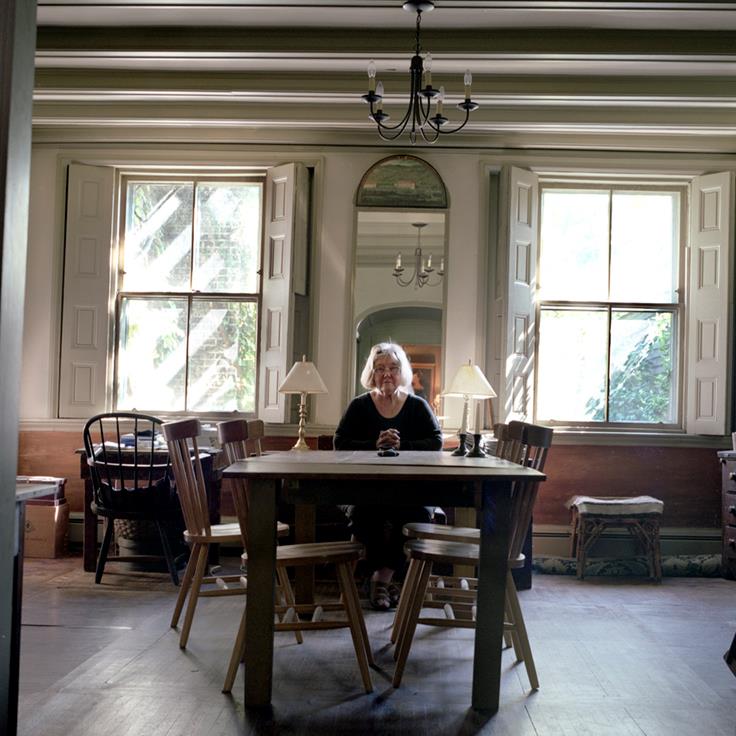 that also likes Amos Lee, Portland, Maine and the Peggy Guggenheim Collection in Venice, but we’ve never actually met- confirm request.
The word “friend” is now synonymous with Facebook and its meaning has been redefined to incorporate relationships formed as loosely as in the situations above. Regardless of how intimate your real world relationships are with your newest virtual “friends,” they receive the same amount of information and become privy to the innermost private details of your life through your Facebook activity, statuses and photos.
that also likes Amos Lee, Portland, Maine and the Peggy Guggenheim Collection in Venice, but we’ve never actually met- confirm request.
The word “friend” is now synonymous with Facebook and its meaning has been redefined to incorporate relationships formed as loosely as in the situations above. Regardless of how intimate your real world relationships are with your newest virtual “friends,” they receive the same amount of information and become privy to the innermost private details of your life through your Facebook activity, statuses and photos.
Yes, you can “poke” others on Facebook, but Maine photographer Tanja Alexia Hollander, has discovered through her own Facebook friendship odyssey that Facebook cannot replace human interactions
Social media has become a fundamental part of our society in the 21st century. Its convenience allows us to instantaneously communicate and share a level of intimacy with those we know well and many we don’t know at all. Despite its presence in our lives today, social networks cannot replicate human interaction. It is arguable, however, that the online environments we’ve created and the resulting reduction of human interaction have an impact on our relationships.
Since the beginning of 2011, Hollander has embarked on a journey to meet (some for the first time) and photograph all 626 of her Facebook friends, traveling across the state, country and world to reach them in their most intimate and private space: their home. Hollander’s photographic and personal journey grew into the project and upcoming exhibit “Are you really my friend? The Facebook portrait project.”
 More than just an exploration of virtual social networks and humans’ dual existence in a cyber space and physical, real world space, Hollander’s project and exhibition explores the evolution and modern-day role of formal portraiture, the meaning of home and the future of human interactions and American culture in an increasingly virtual world.
More than just an exploration of virtual social networks and humans’ dual existence in a cyber space and physical, real world space, Hollander’s project and exhibition explores the evolution and modern-day role of formal portraiture, the meaning of home and the future of human interactions and American culture in an increasingly virtual world.
My project is an exploration of friendships, the effects of social networks and the intimate places we call home. Facebook seemed an ideal forum for this exploration. Though we are in the initial stages of understanding the effects of social networking on American culture and photography there is a pervasive feeling that it is changing our interactions with each other and building a false sense of community.
But do not misinterpret Hollander’s project or exhibition- she is neither defaming Facebook nor purging herself of it upon completion of the project. Quite the contrary, actually. As a result of visiting with and photographing each of her friends, Hollander discovered they do in fact pay close attention to her life online and wanted to follow up about what they saw or read. To Hollander, this gave greater merit and value to the relationships she maintains via Facebook and lessened the gap she was questioned between our simultaneous existence in cyber space and the real world.
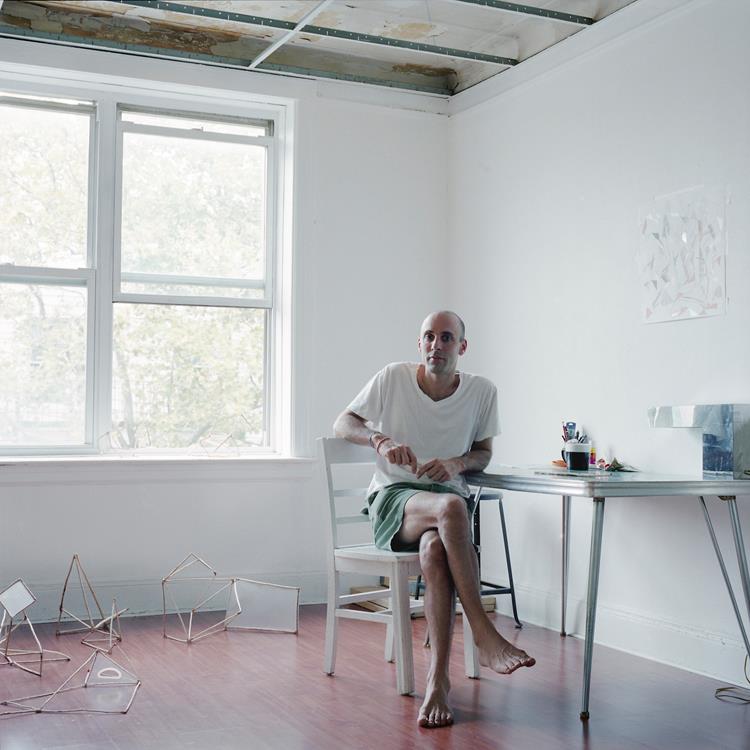 I had the pleasure of speaking with Hollander before the holidays as she approached the final stages of preparing for the exhibition. Since her project has received wide coverage and media attention, I wanted to discuss Hollander’s relationship with social media as co-founder of the self-serving, fine arts photography studio, the Bakery Photographic Collective in Westbrook, Maine. As a manager and artist, Hollander is in the unique position of successfully managing the studio and doing so with a great sensitivity and passion for the arts.
I had the pleasure of speaking with Hollander before the holidays as she approached the final stages of preparing for the exhibition. Since her project has received wide coverage and media attention, I wanted to discuss Hollander’s relationship with social media as co-founder of the self-serving, fine arts photography studio, the Bakery Photographic Collective in Westbrook, Maine. As a manager and artist, Hollander is in the unique position of successfully managing the studio and doing so with a great sensitivity and passion for the arts.
Hollander is admittedly still overwhelmed by the possibilities, perks and opportunities of blogging and social media, though she now considers herself a Facebook expert (and if you have been following Hollander, the project's Facebook page and photographs, you would most definitely agree).
I asked Hollander specifically about the use of Facebook as both an artist and co-manager of the Bakery Photographic Collective
Now I’m obsessed with it. I’m learning as I go. It has been a process of realization of the perks Facebook offers. It has created an audience. Facebook is really important for an artist promoting their own work. In this down economy, artists can’t rely on galleries for sales- that model is shifting.
Hollander plans to turn her Facebook love loose on the Bakery Photographic Collective’s page once preparations for her February exhibit are complete. For Hollander, Facebook has helped her maintain 626 “friendships,” locate each person geographically and most impressively, create a virtual exhibit to complement her real world exhibit at the museum, as each of her photographed friends were asked to upload their portrait as their Profile Picture.
What started out as a personal documentary on friendship and environmental portraiture has turned into an exploration of American culture, relationships, generosity & compassion, family structure, community building, storytelling, meal sharing, our relationship to technology & travel in the 21st century, social networking, memory, and the history of the portrait.
The possibilities of Web 2.0 for artists as creators and managers promoting their work are endless- Hollander says
I am able to post work as I make it, have a dialogue with a global audience, and market - in one location.
Hollander's exhibit opens February 4th at the Portland Museum of Art in Maine.
(Photo Credit: Tanja Alexia Hollander)
All things 2.0: Web, Museum and Photo
Before I introduce Maine artist Tanja Hollander in a soon-to-be-published post, take a look at these persuasive and content-rich lectures addressing certain topics of Hollander's project Are You Really My Friend?: the impact, opportunities and shortcomings of web 2.0 for artists, museums, cultural institutions and art venues.
Not sure what exactly Web 2.0 is or how museums can best use it? Start here, with Nina Simon’s informative and practical explanation of what it is, what it is not and how the museum exhibition can be used as platform for user generated content. Additionally, the video allows viewers like you to leave voice comments following the presentation.![]()
I believe that museums have the potential to undergo a similar (r)evolution as that on the web, to transform from static content authorities to dynamic platforms for content generation and sharing. I believe that visitors can become users, and museums central to social interactions.
If you are well-versed and comfortable with Web 2.0, Andy Adam’s lecture explores the many possibilities for photographers through Photo 2.0 and the role of Photo 2.0 in redefining photography as a medium.
Photo 2.0 – Online Photographic Thinking / SPE Conference at Light Work from Light Work on Vimeo.
Stay tuned for next week's blog featuring Hollander and her upcoming exhibition at the Portland Museum of Art in Maine which celebrates, challenges and responds to the future of a Web 2.0 society.
The Best of 2011
As the year comes to a close, let’s take a look at what topped the charts in the art world in 2011.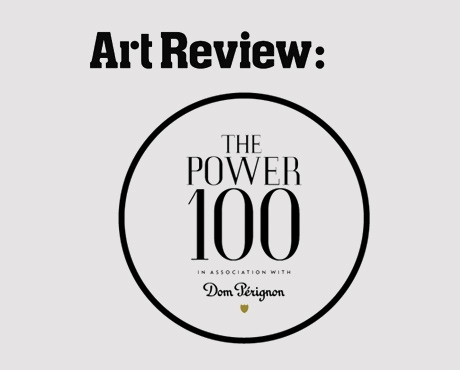
1. The top 100 of the art world’s most powerful figures from ArtReview
2. The top 32 Facebook Best Practices from DIOSA Communications
3. The top 10 reasons to support the arts
4. The top 10 companies supporting the arts in America according to Americans for the Arts
5. The top 10 works of art and architecture according to Philip Kennicott for the Washington Post
6. The top Twitter topics and hashtags according to Mashable
7. The top global topics, statuses, sports teams, music, articles and the like shared on Facebook (for all the locals: the Steelers obviously made the cut) according to Mashable
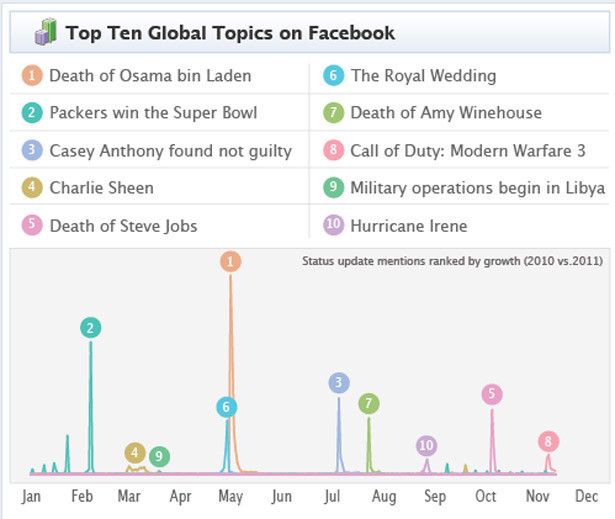 8. The top 50 not-for-profit executives according to the NonProfitTimes
8. The top 50 not-for-profit executives according to the NonProfitTimes
9. The top 15 museums in the world according to the Huffington Post
10. The top 10 private museums worldwide
We here at Technology in the Arts look forward to sharing with you new technological advances, best practices and trends in the upcoming year!
‘Tis the Season for Getting Those Millennials to Give
With the holidays upon us, Baby Boomers and Generation X'ers selflessly reach deep into their pockets, beyond the lint, to give what they can afford 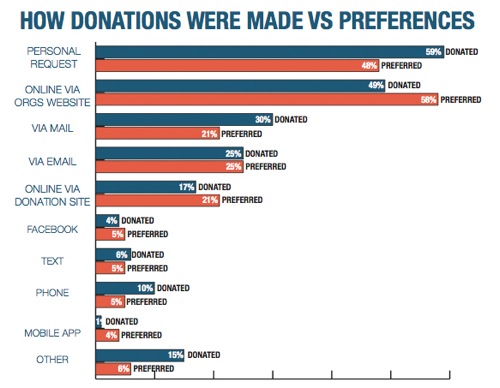 to not-for-profit organizations. But what about the Millennials? How do we get the generation classified in the media and not-for-profit circles as self-absorbed and self-interested to donate? The Case Foundation presents “Millennial Donors Report 2011,” a survey and summary of the motivations and preferences of the Millennials when it comes to making a donation.
to not-for-profit organizations. But what about the Millennials? How do we get the generation classified in the media and not-for-profit circles as self-absorbed and self-interested to donate? The Case Foundation presents “Millennial Donors Report 2011,” a survey and summary of the motivations and preferences of the Millennials when it comes to making a donation.
Earlier this fall, I posted on the best practices for engaging Millennials, the generation of 20 to 35 year olds that is dramatically affecting the way organizations market their brand and product. So in the true spirit of the holidays, let’s take a look at what may seem like an impossible task: getting the Millennials to donate.
The report surveyed about 3,000 Millennials ranging in age from 20-35 years old. Perhaps the most revealing find of the survey is the following: above all, Millennials value trust. A whopping 90% of Millennial donors surveyed reported they would stop giving to an organization if they had any reason not to trust it. What does this mean for not-for-profits? Build personal relationships with your donors and clearly define where and how the donation is used. Because the Millennials are young professionals, students and young adults with limited funds, they are most concerned their donation of any size will be utilized responsibly. Establishing trust with Millennials will encourage future giving and ensure a long-standing donor-organization relationship.
The report is divided into the categories: giving, giving motivators, special events, communication, volunteering, young professional groups and taking action, as they relate to Millennials. Here is a breakdown of the key findings and the implications for your organization
1. 93% of Millennials gave to not-for-profits in 2010
What this mean for you: Millennials tend to make small donations to multiple organizations, as opposed to the Baby Boomers or Generation X that are loyal to a single organization, gifting large sums of money. They ARE donating, which I am sure comes as a great surprise to the many who tag this generation as plugged-in and tuned-out to the rest of world.
2. An online search using an engine such as Google is the #1 way Millennials get information about a not-for-profit organization
What this means for you: How does your organization appear in a Google search? Millennials often base their decision to donate on the organizations appearance in an online search. Pay attention to your organization’s description on search engines.
3. 57% of Millennial donors gave in response to a personal ask
What this means for you: Though the Millennials seem to inhabit the online space more than their physical space, they are surprisingly more inclined to donate in response to a personal ask. However, that is not reflected in their preferred method of donating- 58% of Millennial donors reported they prefer to make that donation online. An unsuspected dichotomy…
The least preferred methods of the Millennial donors are via mobile applications (4%), the phone (5%) and text message (5%).
Reference the graphic “How donations were made vs preferences” in the report to be sure your organization is providing Millennials with the correct channel for giving that addresses their preferences (the most popular of which are online via your website, email, a donation site, or a personal request). Do not let a Millennial donor slip away by simply neglecting to provide the giving tool that best meets their preferences.
4. 79% of the Millennials surveyed reported having volunteered at least once in 2010
What this means for you: Just as expected of the Millennials, they are strapped for time as young adults and professionals. Thus the resounding reason for not volunteering is lack of time. Millennials are not interested in ongoing volunteer commitments. They prefer one-time, convenient volunteer activities. And obviously, they prefer to volunteer with friends than alone- the ultimate trademark of the Millennials. Of those surveyed, 61% reported they would prefer to volunteer with friends and family as compared to the 44% that indicated they prefer to volunteer on their own.
Get creative with the volunteer opportunities you present to the Millennials. They should be convenient, meaningful, group-friendly and perhaps provide an opportunity for professional development. As we saw when considering how donations are made, Millennials respond favorably to person-to-person contact and requests. Do not hesitate to simply ask Millennials to donate their time. As it turns out, 45% of the respondents reported their reason for not volunteering as never having been asked. So ask away!
5. 85% of Millennial donors are motivated to donate by a compelling and meaningful mission or cause, while only 2% of Millennial donors are motivated by a celebrity endorsement.
What this means for you: We already know Millennials crave meaningful content. They Tweet, re-Tweet and post moving videos, inspiring quotes and stirring news reports. Your website can be a perfect tool for tapping into the Millennials need for meaningful content. Share real-life, specific stories of how a donation supported your cause and not-for-profit. Invite the Millennials to be a part of meetings and discussions regarding the inner-workings of your organization and your strategic plan for the future. Millennials crave meaning, worth and inclusion. Invite them to collaborate with you and they will trust your organization.
The report provides cutting-edge research, insight and practical solutions for attracting and developing relationships Millennial donors. As researchers slowly uncover the hidden truths of these mysterious, influential Millennials and their relationship with the not-for-profit sector, we here at Technology in the Arts will continue to bring you the breaking news!
A Bear-y Familiar Conversation
Here is a little video to poke fun at the public's all too common misconceptions of not-for-profit arts organizations. After all, Kanye and Bieber do not ask you to make an additional donation for their performances, why on earth do not-for-profits?! Happy Monday to our arts community!
If Facebook were a country, it would be the world’s 4th largest.
So here are a handful of hints, best practices and basic strategies, as compiled from Heather Mansfield’s blog Nonprofit Tech 2.0: A Social 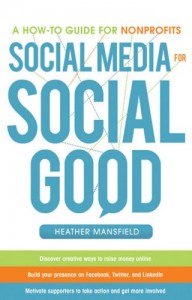 Media Guide for Nonprofits, to maximize the power of Facebook in order to connect with this entire population that is literally, just one click away. Holiday bonus: if you are searching for a special holiday gift for that certain culture vulture or arts manager, consider Mansfield’s recently published how-to guide for not-for-profits titled, Social Media for Social Good. The perfect stocking-stuffer, this comprehensive guide details all the best practices, exemplar not-for-profits and step-by-step instructions (including handy checklists) for building your not-for-profit's online presence and brand- be it a website, an online newsletter, your "Twitter voice," a Flickr account, a YouTube channel, text-to-give technology, tablet applications, etc.
Media Guide for Nonprofits, to maximize the power of Facebook in order to connect with this entire population that is literally, just one click away. Holiday bonus: if you are searching for a special holiday gift for that certain culture vulture or arts manager, consider Mansfield’s recently published how-to guide for not-for-profits titled, Social Media for Social Good. The perfect stocking-stuffer, this comprehensive guide details all the best practices, exemplar not-for-profits and step-by-step instructions (including handy checklists) for building your not-for-profit's online presence and brand- be it a website, an online newsletter, your "Twitter voice," a Flickr account, a YouTube channel, text-to-give technology, tablet applications, etc.
1. Who is the face of your Facebook? Your Facebook page is as good as the social media manager behind it. Creating and maintaining a successful Facebook page (the rewards of which are plenty- Mansfield’s research highlights the direct correlation between the rise of online giving and the rise of social media) depends on the effort and efficiency of the person managing it. Read Mansfield’s blog entry on the 11 qualities of an effective social media manager to be sure your Facebook page is in the best hands possible.
2. Conquer the laggards. Still trying to convince certain skeptical colleagues that this “Facebook thing” is not just a fad? Collect, organize and present to these latecomers the statistics on social media usage (start with a digestible, easy and straight-forward approach, perhaps the video featured above), the trends with rising generations and the shift toward online giving. Still not buying it? Show them what other not-for-profits are doing on Facebook. If you do not join the Facebook community, you are doing your organization a great disservice by becoming less competitive and visible in the not-for-profits sector.
3. You must give some to get some. "Like" other not-for-profit’s on Facebook and engage in activity on their page, with sincerity and moderation of course. Comment on status updates, "like" new posts and respond to news, questions, and comments posted. Not only will you benefit personally from interacting with another not-for-profit and its cause, but by engaging on its wall, you promote your own organization, brand and Facebook page, encouraging Facebook users to explore more about you.
4. Share the love. When updating your own statuses or posting news and comments, be sure to tag any organization you mention (if, and hopefully, they have a Facebook page). This way, your update or post is posted to that organization's wall. Just one more way to put yourself out there…
5. At the bottom of any mass e-mail or automated e-mail response, include a “Like us on Facebook” link to remind your supporters of your presence on Facebook and to give them the opportunity to stayed informed on your progress and activities.
6. Evaluate and adjust. If time after time your posts go “unliked” and your statuses “uncommented,” it is time to consider a different course of action. Facebook is not a newsletter; talk with your followers, not at them. If your Facebook community is not reacting or engaging with the content you publish, evaluate what you are sharing. Is it dead-end content? Does it encourage user feedback? Save the matter-of-fact news for your monthly newsletter and press-releases. Take advantage of Facebook as a community building tool and a platform for exchange.
7. No one likes a Chatty Cathy. Too many status updates and posts per day and that “Hide activity" option on the user's News Feed becomes increasingly attractive.
8. Register for one of Mansfield’s January webinars on successful usage of Facebook and Facebook applications (or check out the other webinars offered on hot topics such as utilizing Google+, YouTube, mobile fundraising, and Twitter).
9. Someone in the office or organization needs a smartphone and needs to be on the mobile web. It does not have to be an iPhone, but in today’s 24/7 streaming news world, it is all about being and staying connected. It is an investment, but one that will be returned as mobile and online giving become the predominant trend.
10. Stay informed. It seems as though Facebook is evolving daily. Do not miss out on the possibilities and potential of the newest features, formats, and most importantly, opportunities for your not-for-profit to expand its reach. Read blogs about the newest changes and innovations in the social media world- a great place to start is right here at Technology in the Arts.
Hope you all had a wonderful holiday!







